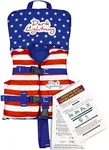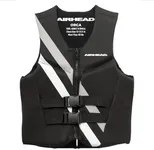Buying Guide for the Best Infant Life Jackets
Choosing the right infant life jacket is crucial for ensuring the safety of your little one while they are in or around water. The right life jacket will provide the necessary buoyancy to keep your child afloat and secure, giving you peace of mind. When selecting an infant life jacket, it's important to consider several key specifications to ensure it meets safety standards and fits your child's needs. Here are the key specs to look for and how to choose the best one for your infant.BuoyancyBuoyancy refers to the life jacket's ability to keep your infant afloat in the water. This is measured in pounds of flotation. For infants, a life jacket should have a minimum buoyancy of 7 pounds. This ensures that the jacket can support the weight of your child and keep their head above water. When choosing a life jacket, make sure it is specifically designed for infants and meets the required buoyancy standards.
Fit and SizeThe fit and size of the life jacket are critical for safety and comfort. Infant life jackets are typically designed for children weighing up to 30 pounds. The jacket should fit snugly but not be too tight, allowing for some room to grow. Adjustable straps and buckles help achieve a secure fit. To ensure the right fit, try the life jacket on your child and check that it does not ride up over their chin or ears when in the water.
Head SupportHead support is an essential feature in infant life jackets. It helps keep your child's head above water and in a face-up position. Look for a life jacket with a padded headrest or collar that provides adequate support. This feature is particularly important for infants who may not have strong neck muscles yet. Ensure the head support is comfortable and does not restrict your child's movement.
Safety CertificationsSafety certifications indicate that the life jacket meets specific safety standards. Look for certifications from recognized organizations such as the U.S. Coast Guard (USCG) or Transport Canada. These certifications ensure that the life jacket has been tested for safety and performance. Always check for these labels when purchasing a life jacket to ensure it meets the necessary safety requirements.
VisibilityVisibility is an important safety feature in infant life jackets. Bright colors like orange, yellow, or red make it easier to spot your child in the water. Some life jackets also come with reflective strips that enhance visibility in low-light conditions. Choose a life jacket with high-visibility features to ensure your child can be easily seen at all times.
Comfort and MobilityComfort and mobility are important for ensuring your child is happy and willing to wear the life jacket. Look for a life jacket made from soft, lightweight materials that do not chafe or irritate the skin. The design should allow for free movement of the arms and legs. A comfortable life jacket will encourage your child to keep it on, which is essential for safety.
Grab HandleA grab handle is a useful feature that allows you to quickly and easily lift your child out of the water. It is typically located on the back of the life jacket. This feature is especially important in emergency situations where you need to act quickly. Ensure the grab handle is sturdy and securely attached to the life jacket.






















